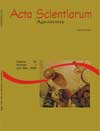<b>Sobrevivência e diferenciação de protocormos de <em>Oncidium flexuosum</em> submetidos a tratamento com ácido peracético e colchicina</b> - DOI: 10.4025/actasciagron.v31i3.697
Resumo
O objetivo deste trabalho foi verificar o efeito do ácido peracético e da colchicina na diferenciação de protocormos de Oncidium flexuosum. O ácido peracético foi testado previamente nas concentrações de 0, 3, 6 e 9 mL L-1, durante dez dias, para verificar a eficácia na esterilização do meio de cultura e os possíveis efeitos fitotóxicos nos protocormos. Após determinação da concentração, foram adicionados 6 mL L-1 de ácido peracético em meio MS com 0,05% de colchicina e DMSO 1%. Os protocormos foram mantidos em agitação pelos períodos: 0, 24, 48, 72, 96 e 120h. O experimento foi inteiramente casualizado com seis tratamentos, dez repetições e cinco protocormos por repetição. Após 30 dias, foi avaliada a sobrevivência dos protocormos e, após 180 dias, foram avaliados: número de brotos, altura da parte aérea, número de raízes, comprimento da maior raiz e massa fresca das plântulas regeneradas. Os dados foram submetidos à análise de regressão. A concentração de 6 mL L-1 de ácido peracético a 0,25% pode ser utilizada em substituição ao processo de filtração da solução de colchicina. O aumento do tempo de exposição à colchicina causou aumento no número de protocormos mortos.Downloads
DECLARAÇÃO DE ORIGINALIDADE E DIREITOS AUTORAIS
Declaro que o presente artigo é original, não tendo sido submetido à publicação em qualquer outro periódico nacional ou internacional, quer seja em parte ou em sua totalidade.
Os direitos autorais pertencem exclusivamente aos autores. Os direitos de licenciamento utilizados pelo periódico é a licença Creative Commons Attribution 4.0 (CC BY 4.0): são permitidos o compartilhamento (cópia e distribuição do material em qualqer meio ou formato) e adaptação (remix, transformação e criação de material a partir do conteúdo assim licenciado para quaisquer fins, inclusive comerciais.
Recomenda-se a leitura desse link para maiores informações sobre o tema: fornecimento de créditos e referências de forma correta, entre outros detalhes cruciais para uso adequado do material licenciado.




















































